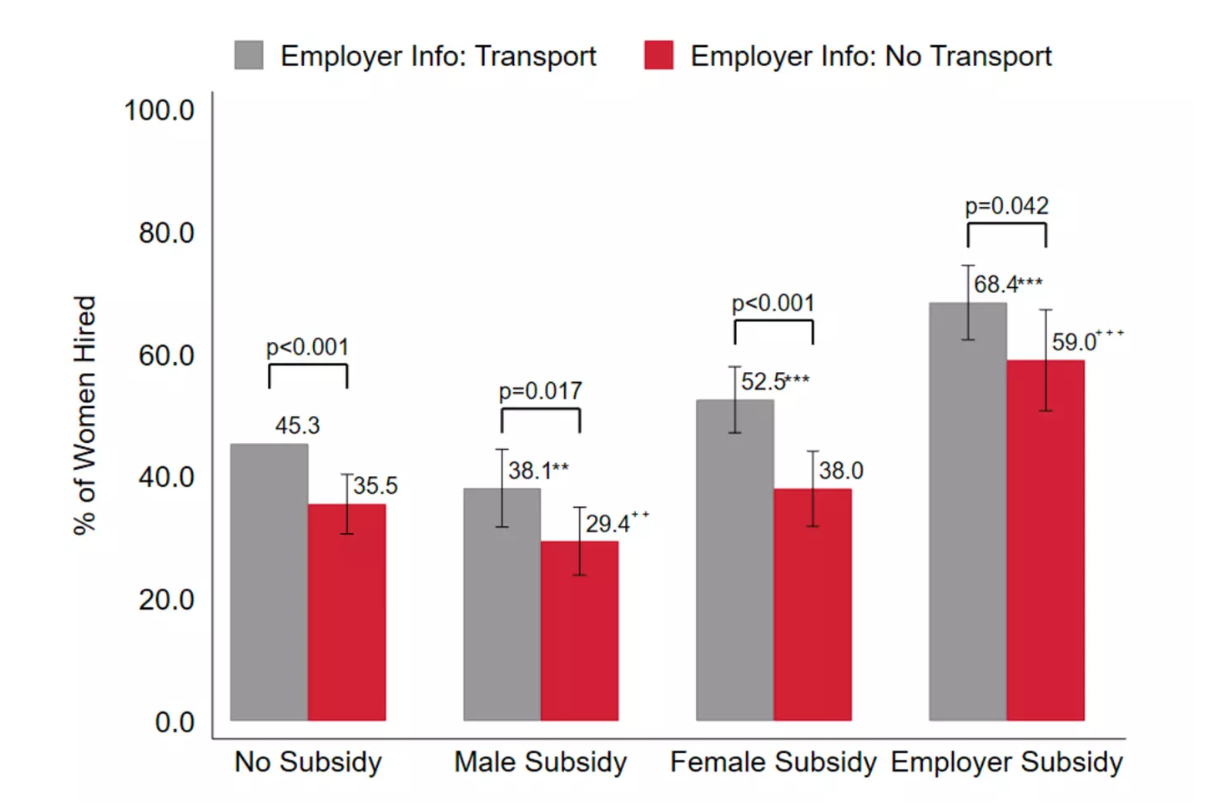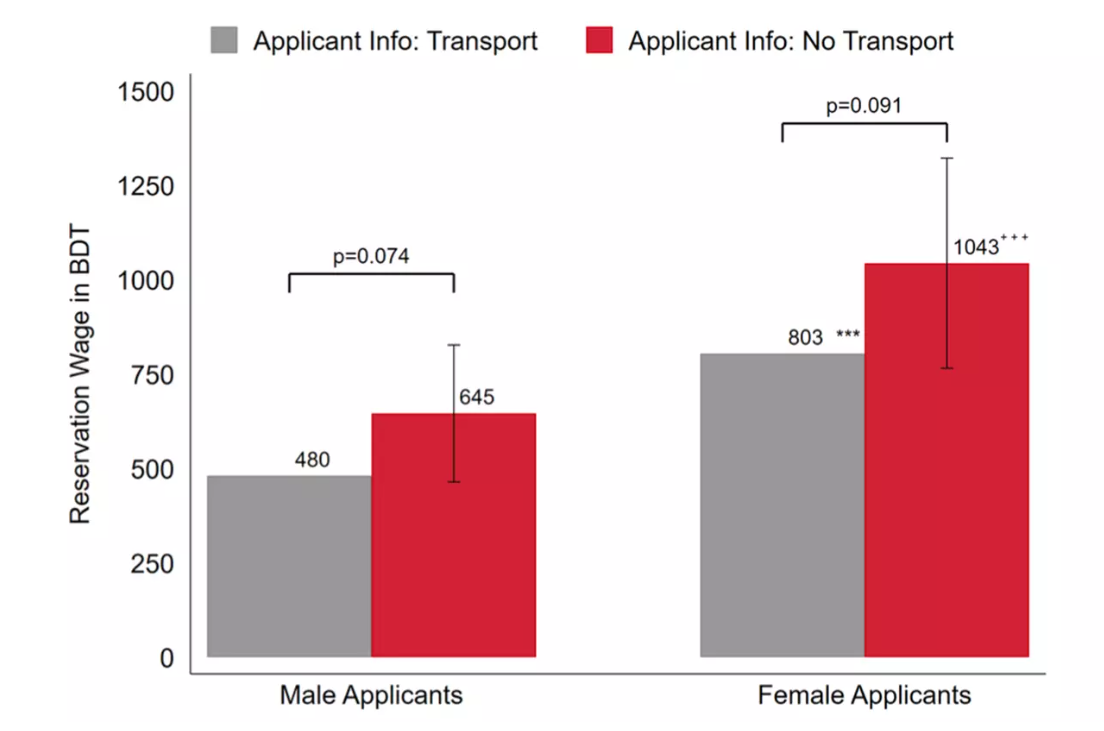
Employers can discriminate and restrict women from taking up employment opportunities deemed unsafe. Research from Bangladesh suggests female workers entering the labour market may suffer most from paternalistic discrimination, where male workers ‘protect’ female workers from tasks perceived as difficult or harmful.
Editor's note: This article originally appeared on the IGC Blog.
Women in Bangladesh struggle to access the labour market, particularly in male-dominated occupations. While 80% of men are employed in Bangladesh, the share drops to only 40% for women. Employed women also get paid less than men, especially in urban areas, where they earn almost 30% less than men. This is, in part, due to substantial gender segregation in occupations, with men working predominantly in services, and women in agriculture and industrial production.
Gender segregation in Bangladesh’s labour markets is exacerbated by restrictive gender norms and gender laws. Laws in Bangladesh do not prohibit discrimination based on gender nor do they mandate equal pay. In the 2018 Bangladesh World Value Survey, 76% of respondents agreed that “men should have more rights to a job than women”, and 67% agreed that “men make better business executives than women”. The laws also disallow women from operating or cleaning certain types of machinery or carrying heavy items.
Traditionally, the economics literature has recognised two types of discrimination: i) taste-based discrimination, in which employers prefer one group over another, and ii) statistical-based discrimination, in which employers believe one group to be more productive than another. We describe a novel form of discrimination that we call paternalistic discrimination: the preferential treatment of male workers in protecting female workers from tasks or jobs perceived as difficult or harmful.
Two hiring experiments to measure paternalistic discrimination
We conducted two field experiments in Dhaka, Bangladesh to test for and measure paternalistic discrimination (Buchmann, Meyer and Sullivan 2024). We observe application and hiring decisions for a job specially created by the research team: a one-time Excel workshop and office job on the night shift (7 pm to midnight) that provided free safe transport to all workers at the end of the shift.
In the first experiment, we examine how demand for female labour responds to employers’ perceptions of safety; in the second experiment, we examine how labour supply responds to applicants’ perceptions of safety.
For the first experiment, we recruited 495 employers — individuals with recent hiring experience — from the manufacturing, retail/wholesale and services, and education industries in Dhaka. We also advertised the job on university campuses, recruiting 990 job applicants. Employers act as hiring consultants, choosing applicants to hire for the job.
The key variation in the experiment changes employers’ perceptions of worker safety, by randomising employers into one of two transport treatment arms:
- Transport: Employers are informed about the free safe transport home.
- No Transport: Employers are not informed about the transport.
In addition to varying information about transport among employers in the experiment, we also varied whether we offer a wage subsidy, paid either to employers or workers. This was done by cross-randomising employers into one of the following four subsidy treatments:
- No subsidy: Male and female workers receive 1,500 Bangladeshi taka (BDT) for completing the shift. Employers receive BDT 500 for hiring any worker.
- Male worker subsidy: Male workers receive BDT 2,500 and female workers BDT 1,500 for completing the shift. Employers receive BDT 500 for hiring any worker.
- Female worker subsidy: Male workers receive BDT 1,500 and female workers BDT 2,500 for completing the shift. Employers receive BDT 500 for hiring any worker.
- Employer subsidy: Male and female workers receive BDT 1,500 for completing the shift. Employers receive BDT 500 for hiring a male worker and BDT 1,500 for hiring a female worker
The amount of the subsidy would allow workers to purchase a safe ride home for themselves. As a result, employers who trust applicants to judge danger for themselves would hire more women with the Female Worker subsidy than with the transport. Only employers who wish to control women’s behaviour would hire more women in the transport treatment than in the Female Worker subsidy treatment.
Finally, we complemented the demand-side experiment with a supply-side experiment. We elicited the reservation wages of 770 applicants, distinct from those in the hiring experiment, who responded to recruitment for the workshop and job on the nightshift. We exogenously vary the perceived job costs by randomising whether we inform applicants that free and safe transport will be provided at the end of the shift.
Employers hire fewer female workers when the work is considered unsafe
Employers consistently hired fewer women when they were not informed about the transportation offered to workers at the end of the shift (see Figure 1). As employers were only making hiring choices over applicants who were willing to take the job, these results imply that employers restrict women’s employment opportunities when employers consider the opportunities unsafe. The effects were particularly strong for female applicants with little experience, suggesting female workers trying to enter the labour market may suffer most from paternalistic discrimination.
Moreover, we find that employers prefer to hire women with a ride than with a female worker subsidy. This implies that employers do not trust female workers to spend the subsidy wisely. Our data bears this out: employers believe that women underestimate the dangers of the job. Employers act by valuing the ride four times higher than the subsidy to workers.
Figure 1: Hiring by transport information and subsidy assignment

Notes: When employers were not informed of the transportation offered, they hired fewer women, thereby restricting women’s employment opportunities when these were considered unsafe by employers.
In the supply-side experiment, we find that both men and women value the ride at the end of the shift at around BDT 150–250 (Figure 2). Applicants and employers value the ride for workers at very different rates.
Figure 2: Application rates by applicant gender and transport assignments

Notes: Male and female applicants value the ride at the end of the shift at around BDT 150–250.
Policy and workplace implications
In our estimations, eliminating paternalistic discrimination would reduce the gender and wage gaps, with the largest effect in the manufacturing industry. Our findings suggest that policymakers ought to consider changes in labour demand when evaluating workplace safety initiatives, crime reduction, and improvements to public transportation. Ignoring paternalism likely understates the benefits of these policies, leading to mistaken priorities. Paternalistic discrimination could also play a role in differential treatment in task assignment, promotion, and layoff decisions, as well as behaviour outside the workplace.
References
Buchmann, N, C Meyer and C D Sullivan (2024) "Paternalistic Discrimination" Working Paper.


